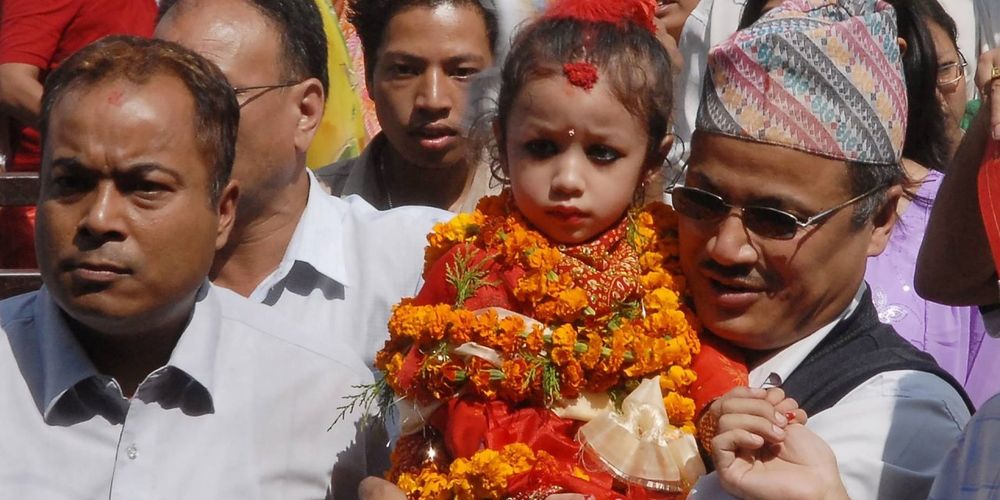
News
3 MIN READ

The tradition has drawn criticism from child-rights activists who say the Kumaris are denied a childhood.

A three-year-old girl was anointed the new "living goddess" of Kathmandu by Hindu priests on Thursday and taken to a palace in the historic center of the Nepali capital where she will remain until she reaches puberty.
Wearing a red dress the new Kumari, or living goddess, Trishna Shakya was taken from her home to the ancient Durbar Square for a short initiation ceremony.
Her father then carried her across the cobbled square—which still bears the scars of a powerful earthquake that hit in 2015—to the temple-palace where she will live under the care of specially-appointed guardians.
Shakya was flanked by her family and barefoot men in red tunics on the short walk, the last time she will be seen in public without the elaborate makeup of the Kumari, or living goddess, until puberty.
"I have mixed feelings. My daughter has become the Kumari and it is a good thing. But there is also sadness because she will be separated from us," her father Bijaya Ratna Shakya told AFP.
Shakya leaves behind a twin brother, Krishna, who cried as his sister was taken from the family home.
As the Kumari, Shakya is considered the embodiment of the Hindu goddess Taleju and will only be allowed to leave the temple 13 times a year on special feast days.
At midnight, Hindu priests will perform an animal sacrifice, which the new Kumari will attend as part of her initiation as a "living goddess".
Historically, 108 buffalo, goats, chickens, ducks and eggs were slaughtered as part of the ritual—a number considered auspicious in Hinduism—but the number has been scaled back under pressure from animal-rights activists.
Goddess to normal teen
The tradition of the Kumari, meaning princess in Sanskrit, comes from the Newar community indigenous to the Kathmandu Valley.
It blends elements of Hinduism and Buddhism and the most important Kumaris represent each of the three former royal kingdoms of the valley: Kathmandu, Patan and Bhaktapur.
The practice was once closely linked to the royal family, but has continued despite the end of Nepal's Hindu monarchy in 2008.
Selection criteria for aspiring Kumaris is strict and includes a number of specific physical attributes such as an unblemished body, a chest like a lion and thighs like a deer.
Even if a girl fulfills all the physical requirements, she must then prove her bravery by not crying at the sight of a sacrificed buffalo.
The tradition has drawn criticism from child-rights activists who say the Kumaris are denied a childhood and their isolation from society hinders their education and development.
In 2008, Nepal's Supreme Court ruled the living goddesses should be educated and they are now taught inside the palace where they live and are allowed to sit their exams there.
Many former Kumaris have spoken about the struggles they face reintegrating into society after they are dethroned.
The outgoing Kumari, Mateena Shakya, 12, left the temple-palace via a side door shortly after the younger girl arrived to take the throne.
Mateena still wore the red Kumari makeup, which includes a "third-eye" painted on her forehead, and the ornate robes of the goddess.
The 12-year-old was carried on a sedan chair back to her family's home, which she left aged three in 2008 when she was anointed as the Kumari.

Features
6 min read
Research shows that disabled people are unequally affected during health emergencies, and this phenomenon is particularly acute in low and middle income countries.
COVID19
News
3 min read
Preventing coronavirus spread in Nepal’s overcrowded jails is becoming near impossible
COVID19
News
5 min read
A daily summary of Covid19 related developments that matter
Features
6 min read
Women prisoners struggle with the difficult choice of sending their kids away or bringing them up in a milieu that could negatively impact their child’s development
COVID19
Perspectives
7 min read
In Nepal, and other parts of the world, domestic workers are routinely denied social and labor protection, and with Covid-19, their problems have only gotten worse.
Photo Essays
4 min read
The coronavirus pandemic brought a faint hope for some that their family members who disappeared during the People’s War might finally return
Perspectives
7 min read
A shadow economy has been flourishing amid unchecked corruption, money laundering and rampant impunity
COVID19
News
5 min read
A daily summary of Covid19 related developments that matter